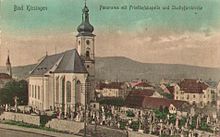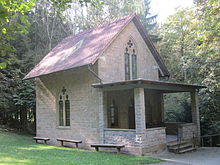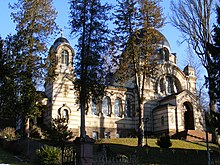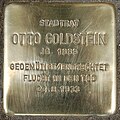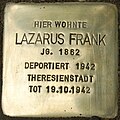Religions in Bad Kissingen
The religions in Bad Kissingen differ in their history from other cities in their spectrum, with the typical characteristics of a world bath , comparable to Baden-Baden . Traditionally, the Roman Catholic Church is predominant in Bad Kissingen . Today's Protestant church was only built in the 19th century as a result of the increasing number of Protestant spa guests. For the same reason, an Anglican and a Russian Orthodox Church were established at that time . Bad Kissingen had the first Jewish residents in the 13th century .
Catholic Church
The exact beginnings of the Catholic community in Bad Kissingen are in the dark. The existence of a Kissingen pastor named Symon is proven for the year 1206. This claimed a third of the tithe in Haard, which belonged to the Veßra monastery founded by the Henneberg burgrave Godebold II . When Pastor Symon ignored a summons from the papal judges in 1207, he was excommunicated. Thereupon he made an admission of guilt in front of the judges and, among other things, successfully asked for his absolution by providing a guarantee.
From an archaeological point of view, today's Kissingen district of Kleinbrach was home to the St. Dionysius monastery , which was first guaranteed for the year 823, and the floor plans of this monastery were reconstructed during archaeological excavations by the Bavarian State Office for Monument Preservation between 1989 and 1991. Traces of a church can also be found in the Bremersdorf desert, first mentioned in 1122 and abandoned in 1394 . The Premonstratensian Monastery of Hausen, which was founded by Count Heinrich von Henneberg and is still preserved today, but no longer used as a monastery, was built in the then village and today's Bad Kissingen district of Hausen .
The first concrete trace of a Kissingen parish is a document from the year 1286, which speaks of a newly built church; however, it is unclear whether this information refers to the Jakobuskirche or the Marienkapelle . The first reliable evidence for both church buildings date from 1341 for the Jakobuskirche and 1348 for the Marienkapelle. Also in 1348, the first known reference dates of the Lady Chapel belonging Chapel cemetery . In a Münnerstadt monastery document of April 30, 1357, three churches in Kissingen are named with the Church of the Blessed Virgin Mary, that of St. James and the Church of the Blessed Virgin Catherine.
In 1394 the parish came to the Würzburg Monastery and from 1429 was part of the Archdeaconate Münnerstadt. As part of the restructuring of the parish district under Prince-Bishop Julius Echter von Mespelbrunn in 1588, the parish of Kissingen was also reduced in size and consisted only of the communities Arnshausen , Botenlaube, Garitz , Hausen , Kleinbrach , Reiterswiesen and Winkels ; The reason for this was that the pastors had to travel too long distances to care for the faithful before the parish was reduced in size. From 1574, the clerical council appointed by the bishop held annual meetings of pastors at which church affairs were regulated.
The existence of a brotherhood dedicated to Pope Urban I. is known from accounts of the 16th and 17th centuries . The last known evidence of the brotherhood in this regard dates from 1687.
As early as 1629, pastor Melchior Pistorius tried to found a Scapular Brotherhood again in Bad Kissingen . In addition, he proved that such an association had already existed in Bad Kissingen and justified the need for a new founding that the former brotherhood, "when the place of Kissingen went to Lutherthumb, declined and stayed in eller (deserted)" . But the re-establishment only succeeded after the Thirty Years' War in 1658 under the parish priest Johannes Seuffert with the help of the Carmelite monastery in Neustadt / Saale The Marienkapelle became the destination of the pilgrimages of the Scapular Brotherhood . The day of the Scapular Festival was set to July 22nd, the day of remembrance of Mary Magdalene . In 1854 Dietz initiated the establishment of a Brotherhood of Fourteen Saints, which was established in 1859.
In 1861 a new chapel was built at Terzenbrunn in today's Arnshausen district because the previous building was too small. Due to the increasing number of Catholic spa guests, the Herz-Jesu parish church was built at the end of the 19th century ; Ludwig II granted permission to build it after several applications only in 1881. The status of the parish church passed from the Jakobuskirche to the Herz-Jesu Stadtpfarrkirche .
The limited capacity of the chapel cemetery made it necessary to expand in 1855 and 1890. At the same time, the construction of a new cemetery on the Sinnberg was planned in 1871; Construction began in 1933, but the park cemetery was only inaugurated in 1936 . As early as 1906, a large Madonna sculpture by Valentin Weidner was set up near the current park cemetery , which had previously been part of the Villa Rosenhügel am Altenberg .
On July 30, 1907, based on the model of Adolph Kolping, the Bad Kissingen Catholic Journeyman's Association was founded, which, in addition to values such as virtue and hard work, also included entertainment and happiness. So in 1960 the group "Foolish Society" was created to hold carnival sessions. A range of professional training courses and hiking care for traveling journeymen have been included in the activities of the “journeymen's association”. In the 1930s there were several changes of club premises; only in 1945 did the association find permanent accommodation in the parish hall. The association's work had to be stopped due to interference from the NSDAP , but was able to revive again after the Second World War .
In 1911, under Pastor Friedrich Roth in Bad Kissingen, an “apprentice association” was set up with the aim of helping young school leavers to spend their free time. In 1922 the apprentice club split into a fist and a soccer department. In 1925 there was a crisis in the club, whereupon it dissolved, but was re-established in 1930. A year later there was a restructuring when the association began not only to take care of the leisure activities of the young people, but also to introduce them to faith and the church, which was to become important in the time of National Socialism . After 1945 a youth home was built under Dean Josef Stürmer.
The Bad Kissingen Catholic Workers 'Association was formed in 1918 under the influence of the workers' question . In the Third Reich, the association fell under the protection of the Reich Concordat of 1933, as long as it was dedicated to religious, cultural and charitable purposes and was neither politically nor unionized. In 1957 the association was renamed "Catholic Workers Movement" and began to keep alive the memory of the papal social encyclics .
On December 8, 1926, the “Catholic Women's Association” Bad Kissingen was founded under the parish priest Albert Susann. It was based on the ideals of St. Elisabeth of Thuringia and a. committed to helping the poor. In the time of crisis in the 1930s, for example, the women's association provided the unemployed with extensive assistance in the form of vouchers. In the time of the Third Reich, the activities of the Women's Association were initially tolerated as long as they were limited to supporting the elderly and sick and political issues were left out. From 1938 the federal government was monitored more and more closely; the number of members decreased steadily. A restart of the activities of the women's association did not take place until 1947.
Under pastor Albert Susann was born in what is now Bad Kissingen district of angle the St. Boniface Church .
| Surname | activity |
|---|---|
| Symon, presbyter de Kyzeche | 1205; 1207/1208 |
| Conrad, plebanus in Kizege | 1286 March 2; 1300; 1313 |
| John | 1341 |
| Andreas de Helderic (by Heldrit) | 1384-1400 |
| Heinrich Tanne de (vd Tann) | 1400 XI. 8th |
| Johann Ubel (e) | 1402 XII. 5 |
| Johann Goswin | 1403-1405 |
| Heinrich Übelin (rect. Par. Eccl.) | 1405 III. 5 |
| Johann Dellich, viceplebanus | 1421 v. 27 |
| Johann Werner | 1488 XI. 19th |
| Kilian Passauer (rect. Par. Eccl.) | 1490 II. 19 |
| Johannes Wüst, executed for supporting the peasants in the peasant uprising | 1524 I. 29 |
| Jakob Niclaus (en) | 1530 II. 26 - 1542 (†) |
| Johann Mor | 1542 IX. 25th |
| Johann Müller (Möller) | 1553-1554 |
| Dean Andres Siegman (n) | 1555 VI. 2-1580 |
| Johannes Philesius | 1584-1586 |
| Johannes Weinrichius | 1587 |
| Johannes Büchs | 1587-1594 |
| Parish Administrator Wolfgang Scharf (f) | 1594-1599 |
| Georg Hofman (n) | 1600-1624 |
| Sacellanus Sebastian Ortloff | 1619 |
| Melchior Pistor | 1615–1622 ( chaplain ) 1625–1635 ( pastor ) |
| Michael Forndran | 1635 (pastor for three months) |
| Melchior Pistor | 1635-1639 |
| Michael Forndran | 1639-1647 |
| Joan Hohman (n) | 1647-1657 |
| Joannes Seuffert | 1657-1669 |
| Conrad Behr (Dean) | 1669-1685 |
| Joannes Georgius Schunck | 1686-1700 |
| Johann Laurentius Helbig (Dean) | 1700-1718 |
| Georg Wielez | 1718-1724 |
| Adam Seydel | 1724-1726 |
| Johann Georg Plaz (square) | 1726-1729 |
| Dean Johann Molitor | 1729-1775 |
| Dean Caspar Wehner | 1775-1789 |
| Joann Adam Huberth | 1789-1809 |
| Andreas Greis (Grays) | 1810-1819 |
| Josef Morsch | 1819-1826 |
| Parish administrator Johann Kaspar Schmitt | 1826-1828 |
| Dean Peter Bauer | 1828-1835 |
| Georg Joseph youth | 1835-1854 |
| Dean Anton Joseph Gutbrod | 1854-1870 |
| Dean Andreas Dietz | 1871-1886 |
| Joseph pitcher | 1886-1895 |
| Friedrich Roth | 1895-1926 |
| Albert Susann | 1926-1945 |
| Dean Josef Stürmer | 1945–1961 |
| Dean Wilhelm Zirkelbach | 1961-1981 |
| Dean Oskar Pflüger | 1982-2005 |
| Dean Thomas Keßler | since 2005 |
Protestant church
For a long time there were only a few evangelical citizens in Kissingen. For the year 1578 a "Protestant deacon" named Nicolaus Nicander is guaranteed. The secularization that began in 1803 enabled the evangelical community in the village to grow , also supported by the health resort.
Encouraged by the increasing number of Protestant spa guests, King Ludwig I , who was married to the Protestant Princess Therese von Sachsen-Hildburghausen , commissioned the architect Friedrich von Gärtner , who had built the spa district with the arcade construction in the 1830s on behalf of the king , also with the construction of the Erlöserkirche, consecrated in 1847 and expanded in 1891 . From March 1, 1850, Kissingen was a vicariate ; this became independent six years later and on June 28, 1864 by King Ludwig II raised to a parish. Today the evangelical parish of Bad Kissingen and the surrounding area has around 8,000 members.
Anglican Church
In the second half of the 19th century, due to numerous spa guests from Great Britain, the first plans to build an Anglican church were made. In 1862, the Anglican Church , financed by donations, was inaugurated in Salinenstrasse . The First World War caused a slump in the numbers of spa guests coming from Great Britain.
In 1953 the church building was bought by the evangelical community; a year later it was turned into a makeshift parish hall. Due to damage to the foundation, it was demolished in 1968; the Protestant parish hall now stands in its place.
Russian Orthodox Church
The first plans to build a Russian church in Kissingen were made in 1856, but these came to nothing; they wanted to give the building of the church to the Russian Tsar Alexander II on the occasion of his visit to the city, but it did not materialize. As the number of Russian spa guests had increased due to two subsequent spa stays by the tsar in the spa town and a railway line between Russia and Germany, the foundation stone for the Church of Sergius von Radonezh was finally laid on July 20, 1898 .
The First and Second World War brought the Russian community life in Bad Kissingen to a temporary standstill. After the Second World War, the Russian charity "Brotherhood of the Holy Prince Vladimir" moved its headquarters to Bad Kissingen in 1961. Russian religious life in the spa town experienced an upswing through the immigration of ethnic Germans from the former Soviet Union after the fall of the Iron Curtain .
Judaism
There were first Jewish residents in the 13th century . Since the rintfleisch pogrom of 1298 they lived as protective Jews in Kissingen, u. a. of the noble family von Erthal , which led to the ghettoization . The situation only improved with the Bavarian Edict of Jews in 1813 . In 1839 the district rabbinate of Bad Kissingen was established . The Old Synagogue was built in 1851/52 as a replacement for the Jewish house of God built in 1705 . In 1902 the New Synagogue was built on Promenadestrasse as a representative building to host Jewish spa guests. The old synagogue was demolished in 1928. In 1925 the community was one of the ten largest Jewish communities in Bavaria with 504 members .
In 1934, the swimming pool affair caused an international stir when the city council refused to allow Jews to enter the city's swimming pool, as a result of which numerous Jewish spa guests stayed away from the city. The New Synagogue was damaged during the November pogroms in 1938 . Despite repairable damage, the Bad Kissingen city council had it demolished in 1939. In 1942, Jewish residents were deported to Izbica and Theresienstadt , killing 69 Jews from Kissingen.
After the end of the war there were no more residents of the Jewish faith, and the community ceased to exist. Later, 25 Jews lived in the village again. In 1959 a prayer room was built in Promenadestrasse and in 1993 in Rosenstrasse with the Eden-Park health resort, the only kosher- run guest house in Germany.
On October 8, 2008, the city council of Bad Kissingen decided to lay stumbling blocks in the spa town as part of the Stolpersteine project to commemorate victims of the Nazi regime. The Bad Kissinger Stolpersteine citizens' initiative was then formed . On June 19, 2009, the first stumbling blocks in the spa town were laid in the pavement in memory of victims of the Nazi regime in front of their last home or last place of work. There are currently 51 stumbling blocks in Bad Kissingen (as of May 2012).
| Surname | Data | Occupation / note | Cause of death | Location |
|---|---|---|---|---|
|
Philipp Münz with son Alfred |
1864-1944 | General practitioner and spa doctor, founder and chief doctor of the Israelitische Kinderheilstätte | Death in the Theresienstadt concentration camp | Theresienstraße 1 |
| Siegfried Wahle | 1869-1941 | Medical council, general practitioner | Deported to Kauen concentration camp | Ludwigstrasse 9 |
| Otto Goldstein | 1889-1933 | Merchant, entrepreneur, city councilor | Suicide after impeachment | Rathausplatz 1 (in front of the town hall) |
|
Sally Mayer with his wife Irma , b. Bretzfelder |
1889–1944 (?) | General practitioner and spa doctor, head of the hospital and retirement home of the Israelite Hospital and Beneficiary Foundation in Würzburg | Deportation to Theresienstadt concentration camp and on to Auschwitz concentration camp | Kurhausstrasse 12 |
|
Gustav Neustädter with his wife Paula , b. Bacharach , and son Ernst David |
1892–? | Last head of the Jewish community, founder of the Bavarian Schochtim Association | Deported to the Izbica ghetto | Promenadestrasse 2 |
|
Ludwig Loewenthal with son Willi |
1898-1944 | banker | Death in the Theresienstadt concentration camp | Ludwigstrasse 5 |
Stumbling block for
Otto Goldstein
Individual evidence
- ^ Adolar Zumkeller: Documents and registers on the history of the Augustinian monasteries in Würzburg and Münnerstadt. In: Sources and research on the history of the diocese and bishopric of Würzburg. Sources and research on the history of the diocese and bishopric of Würzburg, Volume XVIII, Part 1, Würzburg 1966, No. 117, 1357 April 30
- ↑ Erwin Riedenauer: The country offices of the Bishopric of Würzburg, to its staff in the 17th and 18th centuries. In: Würzburg diocesan history sheets. 37/38 Volume, 1975, p. 439ff.
- ^ City archive Bad Kissingen - Kissingen invoices of all income and expenditure, 1603/1604
- ^ Parish archives Bad Kissingen - Certificate No. 1 - Certificate from the Carmelite General FR Marius Venturinus
- ^ Ignaz Gropp : Collectio Novissima, Scriptorum, TOM IV - Würzburg. P. 251.
- ↑ Pfarrarchiv Bad Kissingen - God's House Bill 1760ff.
- ^ Parish archives Bad Kissingen - Catholic journeyman's association Bad Kissingen: The basic laws of the Catholic journeyman's association. confirmed in 1925.
- ^ Hans Karl Schäfer: 75th anniversary of the Kolping family in Bad Kissingen. 1907-1982 "
- ^ Parish archives Bad Kissingen - note 90, meeting on September 19, 1945.
- ^ Parish archives Bad Kissingen - note 111, copy of a letter from the president of the association, Leopold Schwarz, 1937.
- ↑ Unless otherwise stated, the data come from Franz Warmutha 100 Years of the Sacred Heart Parish Bad Kissingen - Contribution to the history of the Parish Bad Kissingen. Bad Kissingen 1984, p. 95.
- ↑ bistum-wuerzburg.de - “With glowing zeal” ( page no longer available , search in web archives ) Info: The link was automatically marked as defective. Please check the link according to the instructions and then remove this notice.
- ^ City Archives Bad Kissingen, Contemporary History Collection, compilation of the City of Bad Kissingen , April 25, 1947.
- ↑ Websites of the "Bad Kissinger Stolpersteine"
- ↑ Collection of articles in the Main-Post ( Memento from November 5, 2009 in the Internet Archive )
- ↑ “Bad Kissinger Stolpersteine” - an initiative by citizens ( memento of the original from April 15, 2012 in the Internet Archive ) Info: The archive link was automatically inserted and not yet checked. Please check the original and archive link according to the instructions and then remove this notice.
- ↑ Question marks as the year of death indicate that the circumstances of death and the date are unknown.



